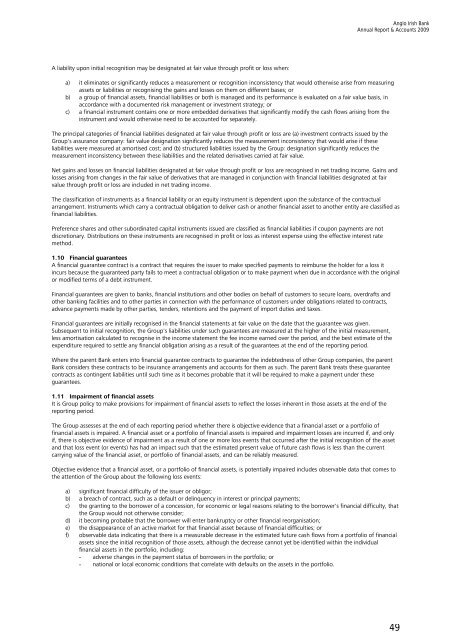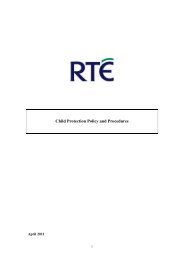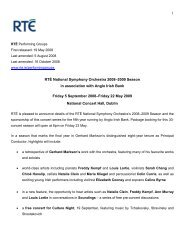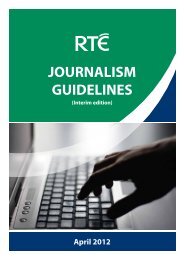Annual Report & Accounts 2009
Annual Report & Accounts 2009
Annual Report & Accounts 2009
Create successful ePaper yourself
Turn your PDF publications into a flip-book with our unique Google optimized e-Paper software.
Anglo Irish Bank<br />
<strong>Annual</strong> <strong>Report</strong> & <strong>Accounts</strong> <strong>2009</strong><br />
A liability upon initial recognition may be designated at fair value through profit or loss when:<br />
a) it eliminates or significantly reduces a measurement or recognition inconsistency that would otherwise arise from measuring<br />
assets or liabilities or recognising the gains and losses on them on different bases; or<br />
b) a group of financial assets, financial liabilities or both is managed and its performance is evaluated on a fair value basis, in<br />
accordance with a documented risk management or investment strategy; or<br />
c) a financial instrument contains one or more embedded derivatives that significantly modify the cash flows arising from the<br />
instrument and would otherwise need to be accounted for separately.<br />
The principal categories of financial liabilities designated at fair value through profit or loss are (a) investment contracts issued by the<br />
Group's assurance company: fair value designation significantly reduces the measurement inconsistency that would arise if these<br />
liabilities were measured at amortised cost; and (b) structured liabilities issued by the Group: designation significantly reduces the<br />
measurement inconsistency between these liabilities and the related derivatives carried at fair value.<br />
Net gains and losses on financial liabilities designated at fair value through profit or loss are recognised in net trading income. Gains and<br />
losses arising from changes in the fair value of derivatives that are managed in conjunction with financial liabilities designated at fair<br />
value through profit or loss are included in net trading income.<br />
The classification of instruments as a financial liability or an equity instrument is dependent upon the substance of the contractual<br />
arrangement. Instruments which carry a contractual obligation to deliver cash or another financial asset to another entity are classified as<br />
financial liabilities.<br />
Preference shares and other subordinated capital instruments issued are classified as financial liabilities if coupon payments are not<br />
discretionary. Distributions on these instruments are recognised in profit or loss as interest expense using the effective interest rate<br />
method.<br />
1.10 Financial guarantees<br />
A financial guarantee contract is a contract that requires the issuer to make specified payments to reimburse the holder for a loss it<br />
incurs because the guaranteed party fails to meet a contractual obligation or to make payment when due in accordance with the original<br />
or modified terms of a debt instrument.<br />
Financial guarantees are given to banks, financial institutions and other bodies on behalf of customers to secure loans, overdrafts and<br />
other banking facilities and to other parties in connection with the performance of customers under obligations related to contracts,<br />
advance payments made by other parties, tenders, retentions and the payment of import duties and taxes.<br />
Financial guarantees are initially recognised in the financial statements at fair value on the date that the guarantee was given.<br />
Subsequent to initial recognition, the Group's liabilities under such guarantees are measured at the higher of the initial measurement,<br />
less amortisation calculated to recognise in the income statement the fee income earned over the period, and the best estimate of the<br />
expenditure required to settle any financial obligation arising as a result of the guarantees at the end of the reporting period.<br />
Where the parent Bank enters into financial guarantee contracts to guarantee the indebtedness of other Group companies, the parent<br />
Bank considers these contracts to be insurance arrangements and accounts for them as such. The parent Bank treats these guarantee<br />
contracts as contingent liabilities until such time as it becomes probable that it will be required to make a payment under these<br />
guarantees.<br />
1.11 Impairment of financial assets<br />
It is Group policy to make provisions for impairment of financial assets to reflect the losses inherent in those assets at the end of the<br />
reporting period.<br />
The Group assesses at the end of each reporting period whether there is objective evidence that a financial asset or a portfolio of<br />
financial assets is impaired. A financial asset or a portfolio of financial assets is impaired and impairment losses are incurred if, and only<br />
if, there is objective evidence of impairment as a result of one or more loss events that occurred after the initial recognition of the asset<br />
and that loss event (or events) has had an impact such that the estimated present value of future cash flows is less than the current<br />
carrying value of the financial asset, or portfolio of financial assets, and can be reliably measured.<br />
Objective evidence that a financial asset, or a portfolio of financial assets, is potentially impaired includes observable data that comes to<br />
the attention of the Group about the following loss events:<br />
a) significant financial difficulty of the issuer or obligor;<br />
b) a breach of contract, such as a default or delinquency in interest or principal payments;<br />
c) the granting to the borrower of a concession, for economic or legal reasons relating to the borrower's financial difficulty, that<br />
the Group would not otherwise consider;<br />
d) it becoming probable that the borrower will enter bankruptcy or other financial reorganisation;<br />
e) the disappearance of an active market for that financial asset because of financial difficulties; or<br />
f) observable data indicating that there is a measurable decrease in the estimated future cash flows from a portfolio of financial<br />
assets since the initial recognition of those assets, although the decrease cannot yet be identified within the individual<br />
financial assets in the portfolio, including:<br />
- adverse changes in the payment status of borrowers in the portfolio; or<br />
- national or local economic conditions that correlate with defaults on the assets in the portfolio.<br />
49

















